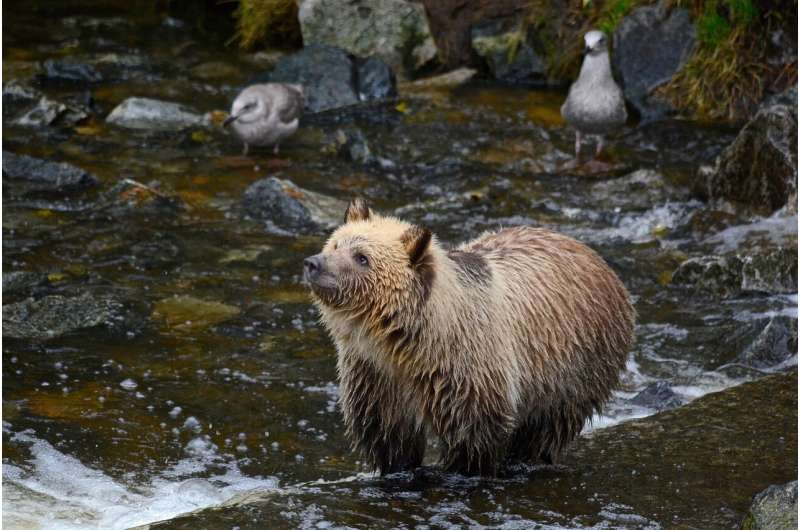This article has been reviewed according to Science X's editorial process and policies. Editors have highlighted the following attributes while ensuring the content's credibility:
fact-checked
reputable news agency
proofread
Feds want grizzly bears back in Washington's North Cascades

The National Park Service and U.S. Fish & Wildlife Service published a final series of proposals Thursday calling for reintroducing grizzly bears to the North Cascades.
Grizzlies roamed much of the West before colonization. A keystone species, bears are known to till and aerate soil as they search for potato-like roots like Alpine sweetvetch, munch on berries, and later deposit the seeds through their scat. The omnivores love to snatch salmon from the river and will steal kills from other predators.
Place names in the North Cascades recognize Indigenous peoples' long coexistence with the bears. Stetattle Creek was derived from stəbtabəl' (stub-tahb-elh), or grizzly bear, in the Lushootseed language spoken by the Upper Skagit people who lived on these lands for at least 10,000 years.
Over time, white settlers wiped the bears off the landscape. Beginning in the mid-1800s, they killed more than 3,000 for their pelts while miners and homesteaders killed countless others. The big brown bears, with a hump of heavy muscle in their shoulders, never bounced back.
No one knows how many grizzly bears remain. The last verified sighting in the U.S. North Cascades was more than two decades ago, and only two sightings have been verified on the British Columbia side of the mountains since.
Returning grizzlies to the North Cascades has been a decade-long on-again, off-again effort. In 2022, the federal agencies initiated the latest effort.
And in the fall, the agencies offered three options for the bears' future in the North Cascades. One option would be to do nothing and the other two would be to reintroduce bears to the area. Under both reintroduction options, about three to seven grizzly bears would be released into the North Cascades each year over five to 10 years. The goal is to establish an initial population of 25 grizzly bears.
Once the initial population is reached, a population of 200 bears would likely be achieved in about 60 to 100 years, according to the agencies.
One option outlined in the plan would allow grizzly bears to be managed as a threatened species under the Endangered Species Act, and permit some to be captured, moved or killed only under specific circumstances, like the defense of life and scientific or research activities.
The second, identified as the agencies preferred alternative on Thursday, is looser and would allow landowners to call on the federal government to remove bears if they pose a threat to livestock, for instance.
This option would designate the bears as a nonessential experimental population and give agencies "greater management flexibility should conflict situations arise."
Under that designation, some of the rules under the Endangered Species Act are relaxed, allowing people to harm or kill the bears in self-defense, or for agencies to relocate bears involved in conflict.
This option was also identified as the preferred alternative in a draft plan released for public comment last fall.
Agencies identified this preferred alternative Thursday, but it's not a final decision. That will come in the weeks ahead.
After years of advocacy the Upper Skagit Tribe is looking forward to the bears return to the rugged North Cascades which Upper Skagit people previously shared with grizzlies for thousands of years, Scott Schuyler, policy representative for the tribe, said in a phone call.
"This is a social justice issue, the fact that the landscape has been, from an Indigenous standpoint, incomplete for so long," he said. "Upper Skagit believes we have a historical moral obligation to restore where we can before it's too late."
During the 45-day public comment period for the draft document, the agencies received over 12,000 public comments. And hundreds of people provided comments at public meetings across the region.
Grizzly bears were listed as threatened species in the lower 48 states under the Endangered Species Act in 1975 and as an endangered species by the state of Washington in 1980.
Some of the best intact grizzly habitat remains here. It includes vast protected wilderness, habitat for dens and hundreds of species of plants, animals and insects the bears feast on.
Scientists have found that under several climate change scenarios, future habitat quality remains the same or slightly improved in the North Cascades, offering enough to support up to 289 female bears. Projected declines in snowpack would result in a decrease in vegetation at the highest elevations, but also an increase in grizzly bear foraging habitat in high-elevation meadows.
Previous efforts to relocate and restore extirpated animals in Washington state and throughout the U.S. have seen success, said Mike Leahy, senior director of wildlife, hunting, and fishing policy for the National Wildlife Federation.
In the mid-1990s, about seven decades after the last wolf pack was killed in Yellowstone National Park, officials relocated 31 gray wolves from western Canada to the park. It was an effort championed by federal agencies, researchers and environmental groups, and at the time received the largest number of public comments on any federal proposal—only to be challenged by grizzlies in the North Cascades.
From 1995 to 2003 officials found wolves preyed on livestock outside the park much less than expected, killing 256 sheep and 41 cattle.
The wolves caused a "trophic cascade" of ecological change; the decrease in elk population helped increase beaver populations and bring back aspen and other vegetation.
"I think it's become a core part of wildlife conservation in America that we restore the species that are depleted when and where we can," Leahy said. "Returning grizzly bears to the North Cascades is just the latest example of all the success and information we've learned from returning elk and deer and turkey and pronghorns and all sorts of other species."
2024 The Seattle Times. Distributed by Tribune Content Agency, LLC.



















